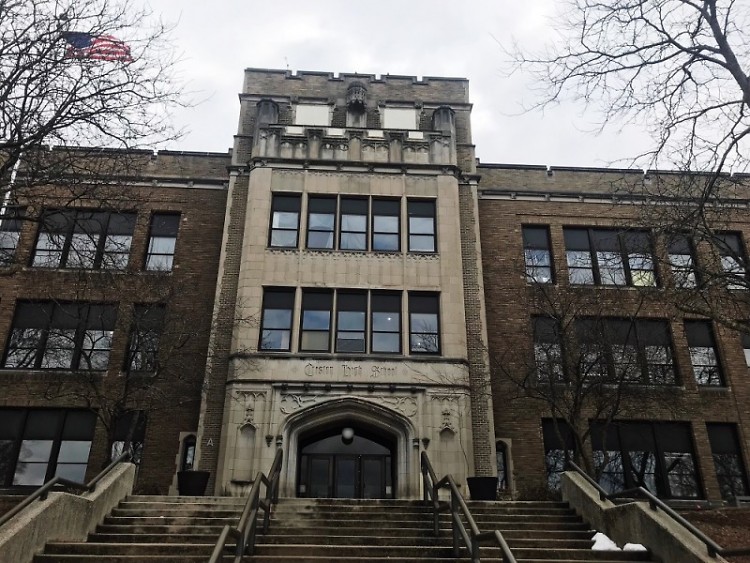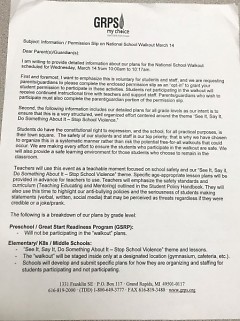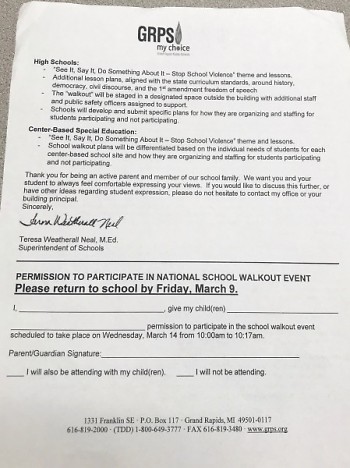The tragic shooting in Parkland, Florida has provoked a surge of activism in students across the nation, including we Grand Rapids students who have planned to walkout in solidarity with the other demonstrators across the country on Wednesday, March 14, 2018.
Grand Rapids Public Schools declared its approval for the event on February 22, 2018. However, many of us in GRPS think that the wording of the endorsement shifts the conversation from us students to the administration, depriving us of our voice, and diluting the power of our movement. Until GRPS sent a letter home declaring its endorsement for the walk-out, the movement was mostly student-led. The endorsement by GRPS itself has been largely well received. It gave more legitimacy to the movement, ensured that we would not be opposed by GRPS, and unified the district-wide movement.
But, since the endorsement comes with a set of regulations, permission slips, and political implications, it is perceived by many of us students as a co-option of our movement and a restriction of our expression.
The GRPS response is, to some extent, understandable. Their endorsement of the movement invites regulations by necessity; after all, the school system has rules it has to follow, and when it takes responsibility for an action, those rules are extended to it. But the way these regulations fundamentally change the organization of the walkout undermines the student-led nature of the movement, and the benefits from the GRPS endorsement do not justify this.
The problems with the district’s endorsement of the walkout are most evident in the letter sent home about the event. The letter contained a short statement of support for the walkout, a rigid plan for each grade level laying out what the students would and would not be allowed to do as part of the demonstration, and a permission slip to be signed by each student’s parent or guardian before they could participate in the action.
In the letter, GRPS made many decisions about the nature of Wednesday’s demonstrations, including the theme, the actions that would be taken, the locations, the exact timing of the demonstrations and who would be allowed to participate in them.
Until the letter came out, all of these decisions were to be made by the student organizers of each school’s demonstration. When they sent home the letter, GRPS also sent the message that we could not be trusted to lead our own movement, and the meaningful decisions should be made by school district officials.
Many students have, understandably, interpreted this as a full takeover of the movement by GRPS. Due to the district’s new role as the central planners of the walkout, the students no longer have any meaningful leadership of the movement, and the demonstrations have been transformed into another system-approved field trip.
Furthermore, the letter laid out strict rules restricting students’ protest privileges based on grade level. While high schoolers are allowed to walk to a designated space outside the building, middle and elementary school students are restrained to locations inside the building, such as cafeterias or gymnasiums, depriving them of the opportunity older students have.
The letter stated that GRPS wanted to make the demonstrations an educational experience; however, in doing so, they have deprived the students of the opportunity to learn how to organize, lead, and, in many cases, participate in the political actions that are so important in a democratic society.
The opening portion of the letter explained the administration’s stance on the walkout, and made a declaration of what the walkout was. The letter declared that the actions taken by the schools and students would be “centered around the theme ‘See It, Say It, Do Something About It - Stop School Violence.’” At numerous other parts of the letter, this slogan was restated, and the theme of harsh opposition to school violence was reaffirmed.
But for all its condemnation of “school violence,” the letter does not address any political agenda; it never mentions guns, gun control, shootings, or legislation centered around any of these things.
It is understandable that the school administration would want to avoid taking a political stance. However, by building this neutral position into the official part of every allowed demonstration in the school system, GRPS is effectively removing our ability to openly support any meaningful change.
When the demonstrations are largely student-led, students have the opportunity to make the movement about political issues that, while controversial, are based around specific ideas for political change. Now, with GRPS enforcing its own party line on the walkout, the movement is forced to take a stance against the vague concept of “school violence” - something to which most people are already opposed, and which does not have one clear-cut solution.
The top-down decision to declare the position of the demonstrations in accordance with the district’s non-political stance effectively takes the opportunity to decide what the walkout supports from each community’s students. It forces a non-confrontational, politically squeaky-clean message on what is really a movement with the potential to inspire real change in our gun laws.
For students, the walkout represents a diverse range of ideas. For many, it represents specific real-world policies, like stricter gun control or meaningful “Red Flag” legislation. For others, it represents an act of solidarity with the victims of the Parkland shooting and the outpouring of related student actions, or a campaign against general school violence in whatever form it takes. The wide range of viewpoints from many different student voices, all working together for change, makes this movement strong. GRPS enforcing their own agenda on the walkout restricts this diversity of viewpoints, leaving only their district-approved message.
The final portion of the letter sparked the most opposition from us. The permission form at the bottom of every letter presents issues of its own, but it also represents what is fundamentally wrong with the GRPS co-option of the movement.
The most obvious issue with the permission slips is it restricts students’ ability to express our views by requiring us to get permission from a parent who may not agree with the demonstration. An unofficial, student-led movement may not necessarily be in line with district rules, but it would ensure that anyone who wanted to participate would have the opportunity to express their views on the issue.
The permission slips represent a condescending, hand-holding attitude that the administration takes towards student protestors. In order to speak our minds and demonstrate for a cause we believe in, students must have express permission from all the authority figures in our lives: parents, school administrators, and school system officials.
It says that the students’ voices are not legitimate unless we are accepted as such by the powers that be and that we require control, coercion, and affirmation at every step of the political process.
The permission slips reveal the true patronizing nature of the GRPS endorsement - GRPS gave us an enthusiastic pat on the back for our good work, and then told us that it is time for the grown-ups to do the rest.
The Rapidian, a program of the 501(c)3 nonprofit Community Media Center, relies on the community’s support to help cover the cost of training reporters and publishing content.
We need your help.
If each of our readers and content creators who values this community platform help support its creation and maintenance, The Rapidian can continue to educate and facilitate a conversation around issues for years to come.
Please support The Rapidian and make a contribution today.


